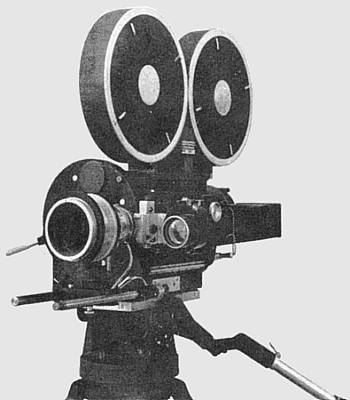cases less, than if the picture had been made in the older methods.
![]() CinemaScope pictures provide a presentation which stimulates the
wide angle experience of human vision and because of this most scenes
can be staged with fewer cuts and camera angles than were formerly
necessary. This, is a big economic saving because the additional angles
required by the older technique were time-consuming and as a result,
costly to make.
CinemaScope pictures provide a presentation which stimulates the
wide angle experience of human vision and because of this most scenes
can be staged with fewer cuts and camera angles than were formerly
necessary. This, is a big economic saving because the additional angles
required by the older technique were time-consuming and as a result,
costly to make.
![]() Another misconception is that the size of the sets must be larger.
Perhaps I can point out why, with CinemaScope pictures they usually
call for less construction and to do this I had better start at the
beginning and explain how the CinemaScope optical units work.
Another misconception is that the size of the sets must be larger.
Perhaps I can point out why, with CinemaScope pictures they usually
call for less construction and to do this I had better start at the
beginning and explain how the CinemaScope optical units work.
![]() As we all know by now, the Bausch & Lomb CinemaScope
attachment lens itself is an optical unit that fits in front of any ordinary
motion picture lens. (See Figure 1.) It follows that it can be used with
any 35mm camera and with many of the lenses that are normally used
with that camera. What the CinemaScope attachment actually does is to
take in an angle of vision, horizontally, two times that which the
photographic lens does without the attachment - the vertical angle of
view is not changed. The picture seen by the lens combination is
photographed in the camera through the aperture shown in Figure 2.
When this attachment is used, for example, on a 50mm lens, the height
of view remains the same but the width of view is similar to that
obtained had a 25mm lens been used. The combination of the
CinemaScope attachment on the camera, the camera aperture, the
projector CinemaScope attachment and the projector aperture (shown in
Figure 3) results in a picture on the screen which is approximately 2 1/2 times as wide as it is high. These same proportions follow with any of
the other photographic lenses. Although the principle is the same, our
newer lenses combine the functions of the conventional camera lens
and the
As we all know by now, the Bausch & Lomb CinemaScope
attachment lens itself is an optical unit that fits in front of any ordinary
motion picture lens. (See Figure 1.) It follows that it can be used with
any 35mm camera and with many of the lenses that are normally used
with that camera. What the CinemaScope attachment actually does is to
take in an angle of vision, horizontally, two times that which the
photographic lens does without the attachment - the vertical angle of
view is not changed. The picture seen by the lens combination is
photographed in the camera through the aperture shown in Figure 2.
When this attachment is used, for example, on a 50mm lens, the height
of view remains the same but the width of view is similar to that
obtained had a 25mm lens been used. The combination of the
CinemaScope attachment on the camera, the camera aperture, the
projector CinemaScope attachment and the projector aperture (shown in
Figure 3) results in a picture on the screen which is approximately 2 1/2 times as wide as it is high. These same proportions follow with any of
the other photographic lenses. Although the principle is the same, our
newer lenses combine the functions of the conventional camera lens
and the

Fig 1.